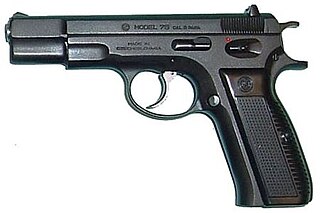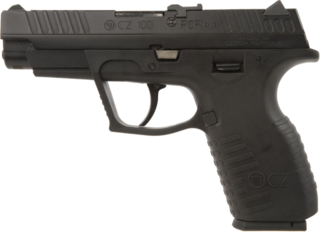 W
WThe Vzor 45, commonly known as CZ 45 is a compact blowback operated semi-automatic pistol chambered in .25 ACP. It was made in Czechoslovakia and later in the Czech Republic. Derived from the CZ-36 following World War II, the CZ-45 is currently manufactured by Česká zbrojovka Uherský Brod as the CZ-92.
 W
WThe CZ 75 is a semi-automatic pistol made by Czech firearm manufacturer ČZUB. First introduced in 1975, it is one of the original "wonder nines" and features a staggered-column magazine, all-steel construction, and a hammer forged barrel. It is widely distributed throughout the world and is the most common handgun in the Czech Republic.
 W
WThe CZ 97B is a semi-automatic handgun introduced in 1997 in the .45 ACP caliber. The CZ 97B is essentially the CZ 75B in .45 ACP rather than 9mm, leading many gun enthusiasts to call the 97B the "big brother" to the very popular CZ 75B.
 W
WThe CZ 100 is a semi-automatic handgun, introduced in 1995 by Česká Zbrojovka. It was the first of CZs weapons to use synthetic materials. It has a sister model, CZ 110, which has a smaller magazine capacity.
 W
WThe CZ 110 is a lightweight Czech 9 mm semi-automatic pistol developed and produced by Česká Zbrojovka of Uherský Brod. The CZ 110 is a double-action (DA) variant of the CZ 100.
 W
WThe CZ 2075 RAMI is a semi-automatic pistol made by Česká zbrojovka Uherský Brod (CZUB) in the Czech Republic. It features a staggered-column magazine, all-metal construction or optional Polyframe, and a hammer-forged floating barrel. The gun's name, RAMI, is derived from combining the first two letters of the designers' given names, Radek Hauerland and Milan Trkulja.
 W
WThe CZ 52 is a semi-automatic pistol designed by two brothers, Jan and Jaroslav Kratochvíl, in the early 1950s for the Czechoslovak military. Around 200,000 vz. 52s were made by Česká Zbrojovka in Strakonice from 1952 to 1954. Before standardizing on the 7.62×25mm vz. 52, the Czechoslovak military used several domestic and foreign pistol models in three different calibers. After 30 years of military service, the vz. 52 was eventually replaced by the 9×18mm Makarov caliber vz. 82.
 W
WThe Česká zbrojovka Vz. 82 is a compact semi-automatic pistol made for the Czechoslovakian military. "Vz" is an abbreviation for "vzor", which translates to "model." A civilian export version is called the CZ 83.
 W
WThe vz. 27 is a Czechoslovak semi-automatic pistol, based on the pistole vz. 24, and chambered for 7.65 mm Browning/.32 ACP. It is often designated the CZ 27 after the naming scheme used by the Česká zbrojovka factory for post-World War II commercial products. However, it is correctly known as vz. 27, an abbreviation of the Czech "vzor 27", or "Model 27".
 W
WThe vz. 38 is a semi-automatic pistol manufactured from 1939 to 1945 and chambered in .380 ACP. The barrel is attached to the frame by a hinge, allowing for very easy disassembly. Certain aspects of the pistol are covered by Czechoslovakian patent 65558 which may also be found as Finnish patent FI18533(A) from 1939.
 W
WKevin ZP98 is a sub-compact semi-automatic pistol manufactured in the Czech Republic. It is manufactured and sold in the United States by Magnum Research as the Micro Desert Eagle (ME380).
 W
WThe pistole vz. 24 was the standard Czech Army pistol of the inter-war period. It was an improved version of the pistole vz. 22, which had been licensed from Mauser. Slovakia seized over ten thousand vz. 24s when it declared its independence from Czechoslovakia in March 1939. The vz. 24 was succeeded in production by a simplified version chambered in .32 ACP, the vz. 27.
 W
WThe Vz. 50 is a Czech made double-action, semi-automatic pistol. Vz is an abbreviation of the Czech term "vzor" meaning model.